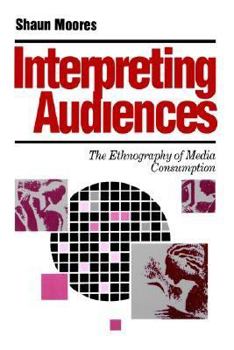Interpreting Audiences: The Ethnography of Media Consumption
Select Format
Select Condition 
Book Overview
In this comprehensive guide to important new developments in the study of media reception, Shaun Moores reviews a wide range of qualitative audience research and charts the emergence of a critical ethnographic perspective on everyday consumer practices. The author considers the distinctive features of audience ethnography and outlines its applications in communication and cultural analysis. Four main areas of inquiry are discussed: the...
Format:Paperback
Language:English
ISBN:0803984472
ISBN13:9780803984479
Release Date:January 1994
Publisher:Sage Publications Ltd
Length:208 Pages
Weight:0.70 lbs.
Dimensions:0.4" x 6.3" x 9.2"
Customer Reviews
1 rating
A good introduction to media studies
Published by Thriftbooks.com User , 23 years ago
Shaun Moores' book doesn't give much new data. He didn't conduct any of his own research. His is primarily a theory book, but it has a great overview of previous authors' presentations of media analysis. He begins by describing "Screen Theory" -- the result of a British journal, Screen, whose contributors analysed media using semiotics, Marxism and a French brand of psychoanalysis. They used this approach to see what kind of "impact" a given text had on its audience. Partly in response to Screen Theory, the Media Group at Birmingham University's Center for Contemporary Cultural Studies developed a concept of 'uses and gratifications' or Gratificationists Theory asking what people DO with media. David Morley was a big part of this movement with his 'Nationwide' Audience. The CCCS writers contributed another concept to media studies -- that is the encoding and decoding of media texts. Using an idea from Bordieu, cultural capital, in determining how capable viewers are in decoding a given text. Morley's book, Nationwide, focuses on the text-to-reader relationship, but later writing, including Morley's own Family Television, examines at how people incorporate media into their daily lives. The context of media, people's preferences and family power structures in whose preference takes precidence became the focus for later studies. Later still, unexamined subgroups become the focal point -- such as differences in genre preferences between the genders and children's abilities to decode media. Moores then discussed the role of changing technologies in media and family life. The early availability of radio is used as an example. Early radios were considered "man's world" of 'gagets.' When only a headset would allow a person to listen, who could use the headset provided an access point to analysis of family power flows. Later, as radio technology developed and broadcasting allowed the whole family to listen together, the social dynamics surrounding the radio changed. This provides an interesting historical case study that could be applied to other media forms, such as computers or the Internet. Understanding or analysing availablity and the economic and cultural capital that fascilitates access to the Internet could contribute to clarity in the value of the Internet in the global village. Finally, Moores unpacks the concept of understanding audiences by their demographics. Overall, a very useful piece of scholarship in the field of media sociology.






